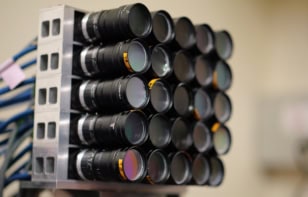
Tiny sensors with the ability to roam can be a great aid to doctors, returning information from some hard-to-reach locations inside the body. A problem arises, however, in powering these devices. Standard fuel cells are too large and it is very difficult to “replace the batteries” once a sensor is inside the body. Researchers in Italy are proposing a solution in which mobile electronic devices “harvest” the energy of natural vibrations inside the human body.
“Over next 5 to 10 years we will be faced with a huge number of microscale mechanisms. A big question is: how do we power them?” said Luca Gammaitoni, one of the researchers at the University of Perugia.
Gammaitoni and his colleagues have the idea to create sensors from piezoelectric materials, which generate tiny electric currents when flexed by ambient vibrations. Although the principle of converting ambient noise into useful energy is not a new idea, the researchers present a technique for “broadband” harvesting of a wide range of vibrations.
Electric swingers
To demonstrate the concept the physicists took a piezoelectric beam and subjected it to both linear and nonlinear oscillations. Reporting their findings in Phys. Rev. Lett., they claim that the nonlinear oscillators yielded 4–6 times more energy than the linear ones.
Existing methods for energy harvesting have focused on harvesting vibrations at specific resonant frequencies. However, according to Gammaitoni and his colleagues, this approach is not suitable for devices inside the human body where the majority of ambient vibrations are distributed over a wide spectrum of frequencies. So the physicists designed an experiment to determine, as a general principle, whether nonlinear oscillators allow a larger energy harvest than linear oscillators.
Included in the experimental set-up was a steel pendulum mass, the swing of which was controlled by magnets on either side of the pendulum tip. Attached to the pendulum mass was a beam of piezoelectric material that was clamped at the base and so flexed every time the pendulum swung. By varying the distance between the magnets and the steel mass, the researchers were able to facilitate both linear and nonlinear oscillations.
Scaling down
“This is a neat new approach to harvesting energy from nonlinear vibrations. However, scaling this principle down to make useful biomedical devices will be a challenge because power output scales with internal deflection — if the pendulum hasn’t got room to move very far it can’t produce much power,” said Eric Yeatman, an electronic engineering researcher at Imperial College, London.
The patent for this new technique is held by Wisepower, a spin-off company set up by Gramaitoni and his colleagues in Perugia. Wisepower will now turn its attention to the practical challenges of converting this principle into working devices, Gammaitoni told physicsworld.com.
“We are looking to develop a prototype that could pave the way for microscale applications. One of our big problems at the moment is getting the funding — Italy at this time is not a great place for development. Right now we are open to investors from across the world,” said Gammaitoni.



